From 80s droopy top to V-neck now!
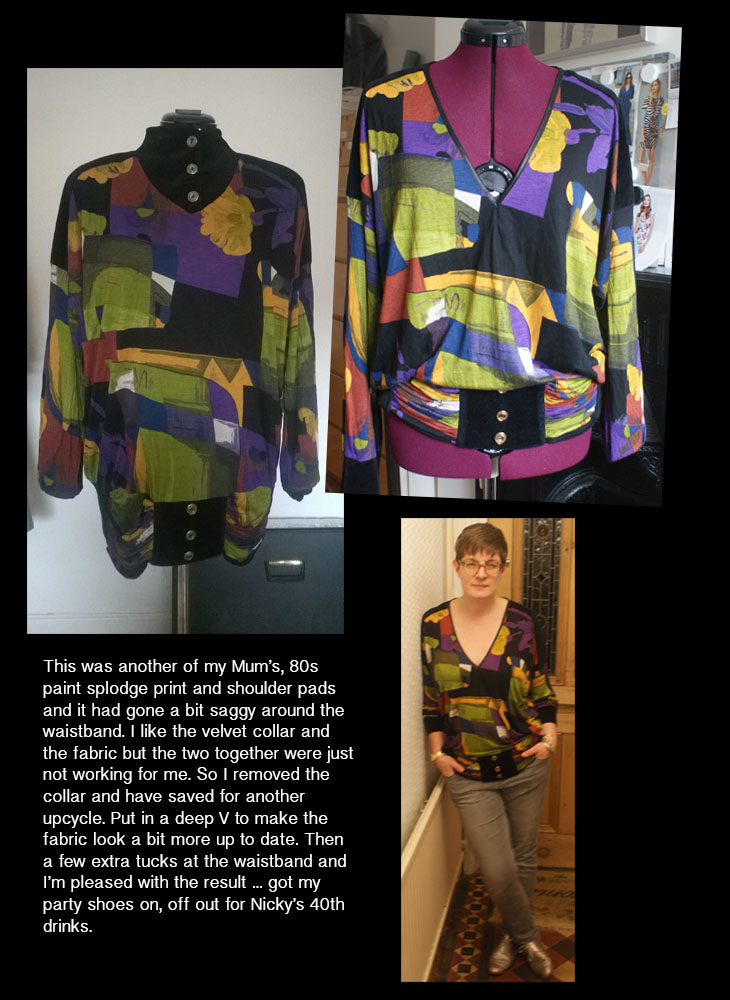
From 80s droopy top to V-neck now!

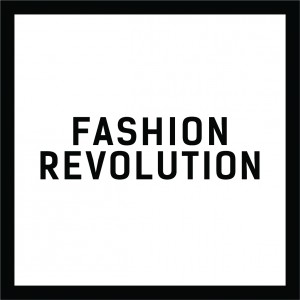
There is an amazing organisation, I’ve talked about them before, founded by Carry Somers and Orsola de Castro called Fashion Revolution. In 2013 when the Rana Plaza building in Bangladesh collapsed killing 1,134 and injuring 2,500 who were making clothes for the Western market, these two ladies decided enough was enough. They have campaigned since for a fairer, cleaner, more transparent and more beautiful fashion industry.
24th April is the anniversary of the disaster, declared Fashion Revolution Day and every year since professionals and consumers have asked, via social media, their favourite brands one vital question which most brands are still unable to answer.
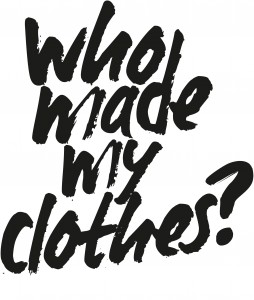 This year they have gone a step further and declared Fashion Revolution Week 18-24th April, with their #haulternative campaign when each day will have a different focus. So I’m going to join them. As well as asking my own favourite brands the million dollar question I will post every day, talking about a different aspect of my approach to ethical fashion. There is huge debate about whether change will be brand led or consumer led but the reality as always is that unless we all join together, people will continue to be forced into unfair employment and poor working conditions. The environment will suffer as chemical waste is added and vital resources are taken away.
This year they have gone a step further and declared Fashion Revolution Week 18-24th April, with their #haulternative campaign when each day will have a different focus. So I’m going to join them. As well as asking my own favourite brands the million dollar question I will post every day, talking about a different aspect of my approach to ethical fashion. There is huge debate about whether change will be brand led or consumer led but the reality as always is that unless we all join together, people will continue to be forced into unfair employment and poor working conditions. The environment will suffer as chemical waste is added and vital resources are taken away.
A few weeks ago, I posted my ethical guide to fast fashion. My Fashion Revolution posts will tell you how I follow this guide and hopefully, give you some pointers on how we can all play a small part for the greater good and our future generations.


I wanted to share my latest charity and local shopping triumph with you. The jacket is C&A .. what can I say? I’m a 70s child, that alone and I had to buy it. It was a bonus that it was a gorgeous long, suede waistcoat. I love a waistcoat, great for hiding the extra curves my 3 kids have left me with! And you don’t see many long length ones, so I snapped it up .. £10. I did try to negotiate but as I’ve said before, charity shops know their market better than ever and the value of things. And why not? It’s in great condition, it’s the real deal and I’m sure I’ll get £10 worth of wear out of it. It came with a beautiful soft belt, which I’ve taken off and worn with other pieces.
The jewelry was bargain of bargains! I was looking for an 18th birthday present for a very dear friend, I’ve known all her life. I had spotted a bracelet in a jewellers but her mum had also said she was into stationary and I saw a gorgeous and clever journal (the lines are the words of the novel in tiny text!). The two together were over my budget! I thought I’d check out the Arbery Emporium, a shop that sells upcycled furniture and pre-loved items where I often go for a browse for presents and gift inspiration. I spotted a few pieces of lovely jewelry and a very pretty box.
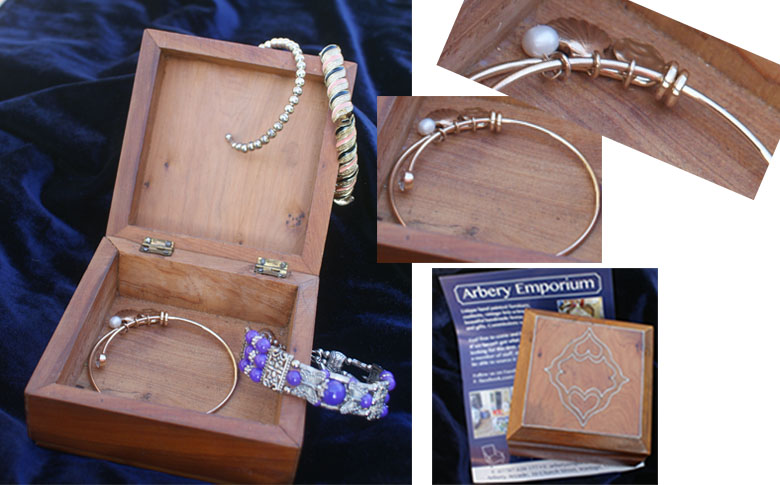
One of the pieces was a gorgeously pretty gold charm bracelet, a fraction of the price of the new one at the jewellers and way more unique. AND enough money left for the journal aswell!! I made a little satin cushion for the box, the bracelet looked a treat. I think perhaps some people would think it’s weird to give second hand for a present but to me the fact that it is second hand and has a story already is what makes it totally unique and special … hey, I’m living the dream and taking a few friends with me, I’m sure Lauren gets it;

This one was for me, I wore it to her party with my Lauren dress, to be posted soon. Where else would you get that amount of detail for less than £10?!
Ethical fashion code: for trends, shop second hand and upcycle. Here three garments become one and I have a bomber jacket .. one of this spring’s trends.
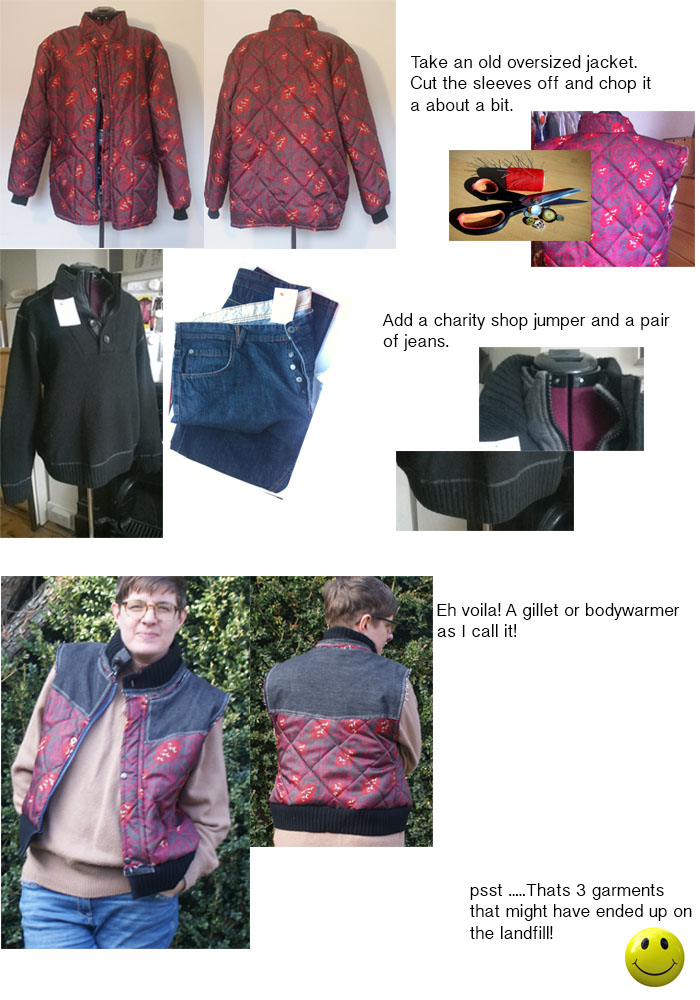
It wasn’t all plain sailing though, in truth, this one was a bit of a nightmare and left even me wondering whether I should jump on the bus to the high street!
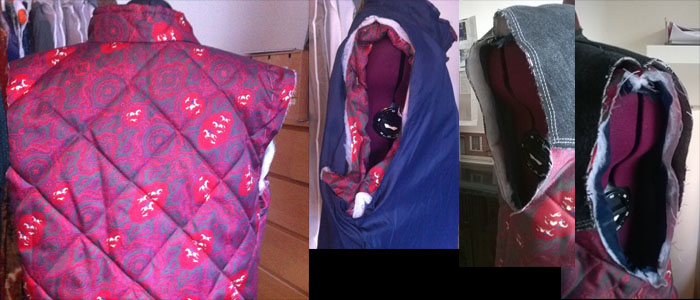
Getting the armholes even was the first challenge. It was very oversized and I guess as a sleeveless jacket the shoulders looked more exaggerated than they had when they had sleeves. Then I got caught out by the lining .. when a garment is made from scratch there is a particular way it needs to go together so that the finishings are hidden and edges enclosed … circumventing this and working backwards as you have to do with upcycling is sometimes a bit tricky. Then, just when I thought I was on the home straight! Doh! I thought I was being clever using raw edged denim, no need to finish the edge and picking up on a Spring trend. But oh no, I realised I had not considered the edge of the wadding and the jacket .. oops, I didn’t see any of that on the catwalk! Learnt a few things about zips too (it doesn’t actually fasten)!
All in all, many lessons learned and with the help of YouTube tutorials, we got there and I’ve worn it twice this week. Had a few nice comments from friends which always makes it feel worth the effort. It’s not perfect but one day I’ll have another go and make another one. As far as upcycling goes, I’m chuffed with the fact that I managed to use the welt and collar from an unwanted jumper and the denim from an unwanted pair of jeans … TOTAL UPCYCLE!
A bit of a side comment … go careful when you hear the word “vintage”. I bought the jacket from a well known second hand market place online, advertised as vintage, worn by a very cool looking model with a price tag to match. Actually, I don’t think it is vintage at all but I probably paid three times what I would have done if it had just been labelled second hand … another lesson learned … my brain is hurting now!

For some years now I have felt uncomfortable about shopping on the high street. As someone who makes clothes, the prices seem too low to make any sense for the time and materials involved. There has been disturbing media coverage about some brands and their lack of protection of their workers. And I suffer from ezcema, I know first hand the damaging effects of chemicals and wonder about what they are doing to our environment. There are brands marketed as ethical brands but they tend to be smaller, with a smaller product range and cannot cater alone for my needs. And there are high street brands I like and I want to use, the high street suits my budget and I don’t believe that a high price point equals better ethics. So I want to become more brand-savvy, find out which brands take ethics seriously and be more informed when using the high street.
An important thing to say is that this is my opinion, based on my principles and my personal moral code. I am not trying to tell people where they should shop, I am going to tell you were I feel comfortable shopping and you can make you own judgement from there. This has been a rollercoaster of a post to write as it’s such a complex area but I feel strongly that we should know more about all this so I’ve stuck with it.
Ethical Fashion: What are we so worried about?
There are many, many aspects to ethical and sustainable fashion relating to the protection of the environment and of people and there are many aspects to the protection offered by companies. These are a couple of well-rounded and straightforward definitions worth keeping in mind as you read.
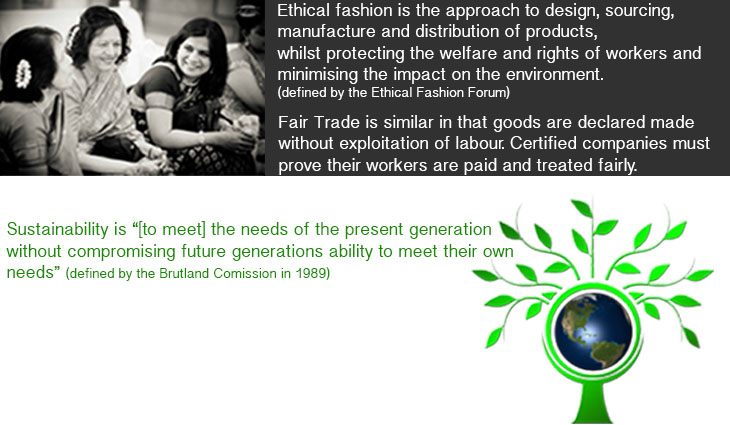
Fashion Industry Supply Chains
The thing that is challenging about seeking an ethical buying approach in the fashion industry is that in many cases from design to purchase is a enormously long supply chain and ensuring all levels are protected relies on a lot of people spread across long distances. For a t-shirt sold in the UK, the cotton may be grown in Uzbekistan, sent to textile mills in India to be spun and woven into fabric, then sent to Bangladesh to be cut, sewn and finished. Cotton is a pesticide intensive and water thirsty crop, imagine the carbon footprint of that journey and the number of people involved at each stage. So imagine also my joy when I discovered there are one or two organisations who are many steps ahead of me and have already compiled data and reports on many brands using a simple grading system .. ah but nothing in life is ever simple, is it (are you feeling the rollercoaster yet?)

Baptist World Aid (www.baptistworldaid.org.au) is a not-for-profit organisation committed to empowering the world’s poor to lift themselves out of poverty. Using a grading system developed by Free2Work they compiled a report entitled Apparel Industry Trends 2015: The Truth Behind The Barcode focusing on the state of the industry’s protection of people, workers and communities. The report asks brands a series of questions in 4 areas.
The report is very in depth and looks at the Australian market but it includes a number of international brands such as Nike and Levi’s. From analysis of the questions, brands are given an overall grade ABCDF (no E??). Grades A and B are given a green thumbs by the organisation, C is a yellow partial pass and D and F are both red thumbs down.
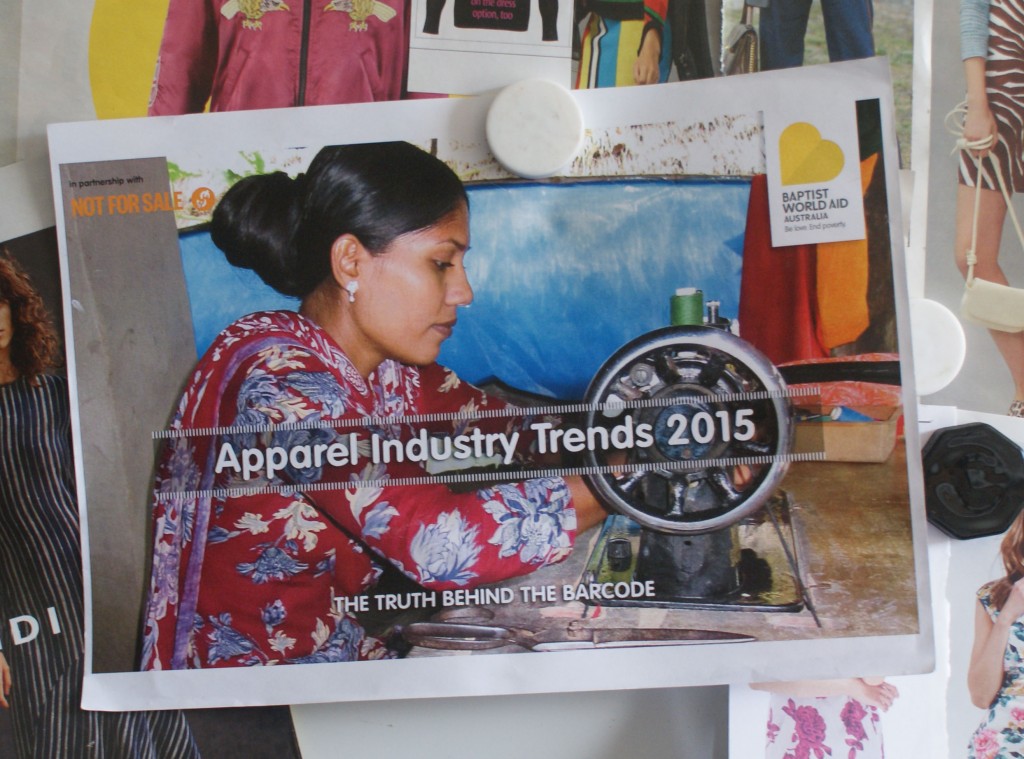
Rank a Brand (www.rankabrand.org) is based in Amsterdam and is Europe’s largest brand comparison site looking at a number of industry sectors including fashion. Volunteers search brands websites to find the answers to a set of 16 questions targeted to judge a company’s policies towards labour conditions, environmental practices and climate change initiatives. It has over 1000 brands in its fashion, clothing and shoes section; you can ask about a brands not yet rated and even poke a brand you want to encourage to take part. The website ranks brands with grades ABCDE and gives the following definitions to those grades.
So where do I stand on all of this?
It’s no simple task to decide where I stand on all of this, I have poured over these comparisons, run round in circles with the various criteria and my head hurts trying to reach some sort of conclusion. This is a huge industry and there are millions of brands and I’ve surprised myself how many of them I use, particularly when I take into account the childrens’ clothes as well. There are holding companies whose names we are not familiar with so it’s not always straightforward to judge. And not every brand has been rated. For example, our dear Clarks where I often buy the school shoes is given an E by Rank a Brand but how do I know Start Rite is any better as it’s not rated?
Rank a Brands questions do not seem especially onerous, it’s pretty shocking to think that those brands scoring E by Rank a Brand have only managed to positively answer 2 or 3 of the 16 questions, those scoring a D between 3 and 5. However, there are only 2 brands that Rank a Brand have given an A and brands I know to be progressive in ethics such as People Tree have achieved a B. My interpretation on this is that because Rank a Brand are looking at the environmental aspect of ethics as well as the protection of people, the criteria is broad rather than deep and companies may not be able to wholly satisfy questions, though they may be taking steps to address the issues. Therefore, their rating comes out lower compared to Baptist World Aid, who focus on people so that their questions are able to delve a little deeper into the complex issues around employment.

I’m concerned about both the environment and the people who make my clothes so my first instinct is to say I will not use brands that Rank a Brand have given a D or E but Nike were given a green B by Baptist World Aid and when I look at their website it seems they are making a big commitment to environmental sustainability. And Levi’s are also a D brand, given a green B+ by Baptist World Aid so at least they are making a commitment to ethics, where many jeans brands are not even featured. It is all relative as there are many, many brands not featured and surely taking part in the research counts for something.
This is a hugely complex area so forgive yourselves, my friends on Facebook, who apologised for seeming lazy, few of us have time to navigate all of this. I’ll forgive myself too for taking a whole week to write this post and for not being able to come up with a simple list of trusted brands. It’s been a tough week, but it tells me I need to keep going, reminds me that this is the start of a journey and I can make lots of small changes rather than one big one. I was getting overwhelmed trying to predict which brands you might use, pick out the ones I use and then noticing more as I dressed the kids and myself this morning. I was also trying to come up with a blanket statement such as “I will only use A brands” but then I realised that H&M (one of my staples) has a C from Rank a Brand but an A- from Baptist World Aid so much of this has to be judged on a brand by brand basis. So this is what I’ve done, I’ve routed through my own wardrobe and photographed a label of some of the brands I use, then I’ve made my own judgement using the grades above and my own knowledge. Here are my thoughts;

Hold on tight, fast fashion is set to get faster with a new trend called “see now, buy now”. The fashion calendar currently kicks off with designer brands showing their collections for the season ahead in New York, London, Milan and Paris. Buyers make their selections and place orders. Then the garments are produced, known as cut-make-trim …. so the fabric is cut then the garments are manufactured and finished ready for sale. Show to store takes about 4 months. However, some designer brands are shifting the cycle so that garments will be available as soon as they hit the catwalk. There are all sorts of implications for professionals within the industry but I’m not going to comment on those. I just want everyone to STOP and think what this actually means … this massive global industry is going to throw even more at us! And we’re going to be tempted to buy even more! The high streets are going to race faster and harder to copy the catwalks, the media is going to tell us about even faster changing trends, our wardrobes are going to burst at the seams whilst our bank accounts will get redder and redder … and we’ll still say we have nothing to wear! STOP!
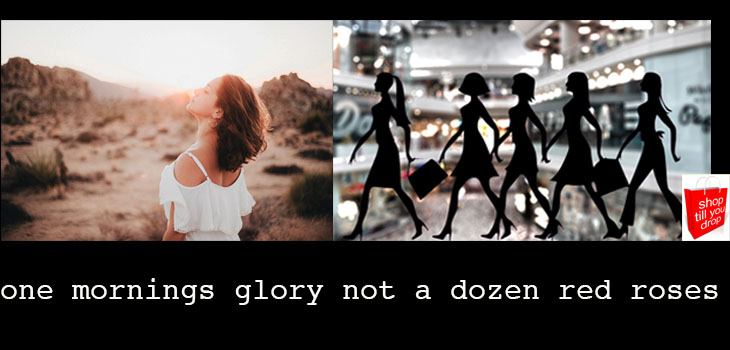
The Japanese art of Wabi-Sabi .. find beauty in all things and value authenticity above all, everything today’s sleek mass-produced, tech-saturated culture isn’t. There was an article in the Guardian at the weekend about Lidl’s £5.99 jeans (I’ve shared it on Facebook and Twitter). Are we really saying that it makes sense that a pair of jeans we might wear dozens of times can be made for the price of two cups of coffee! Again STOP! This just doesn’t make any sense … #if it seems to good to be true, that’s because it is!
BUT, I love fashion and clothes, I read magazines and I pick up trends to update my wardrobe and my mood! £5.99 for a pair of jeans screams WRONG to me but it’s not always that obvious. Brands will say they are led by their customers but how many of us feel like leaders? When I’m in a store, confronted with bargain after bargain, rail after rail and that compulsion to buy … I feel more like a sheep! I make random, impulsive decisions and take home clothes I didn’t need and discover I don’t want! I guess the brands are right though, they’re in it for the profit and if we are buying then they will respond to that, regardless of how empowered we feel in making the decision to buy. We need to care more and take a step back, think about why that new outfit is a bargain and do we really need another little black dress?! A girl can never have too many little black dresses? Actually, she can, there are only so many days in the year, parties to go to or occasions to scrub up for. STOP! THINK!
So, this is my solution, my ethical guide to help me navigate this fashion industry that I love and hate at the same time!

I’ve been promising myself a trip to London since I wrote my Happy New Year post and invited culture to my 2016 party. An article featuring the ten best charity shops in London and the need for a haircut (my hairdresser recently moved from Oxford to London) was the incentive I needed. Why has it taken me until March? Honestly, it’s become a bit of a thing after the Paris attacks, I’ve been nervous about visiting London. I’ve been off yoga for a few weeks because of a back problem but I went to a lovely twilight session on Friday. As well as the hilarious frequent use of the word “buttock”, my lovely teacher ended with a fab relaxation and we were asked to chose a mantra to chant in our heads. I chose “I’m living, I’m safe!”, it relaxed my worries and I was on the train .
.
So my plan for the day, following a haircut with the lovely Charles at Electric in Marylebone, I chose 3 stores from the article located around that area. Given the size and population of London on a Saturday, I thought 3 might be enough and I also wanted to check out Livia Firth’s spring collection for M&S, Made With Integrity and have a drool over some new trainers at Niketown to kick off my brand research. So, what to wear? I can be a bit braver with my outfit for the city than I would at home and of course, second hand rules!
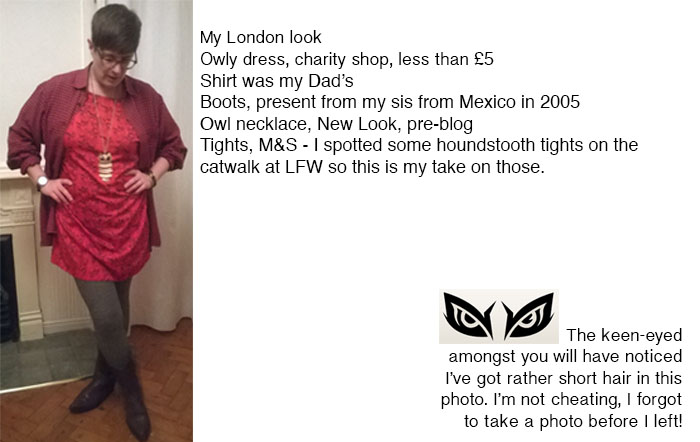
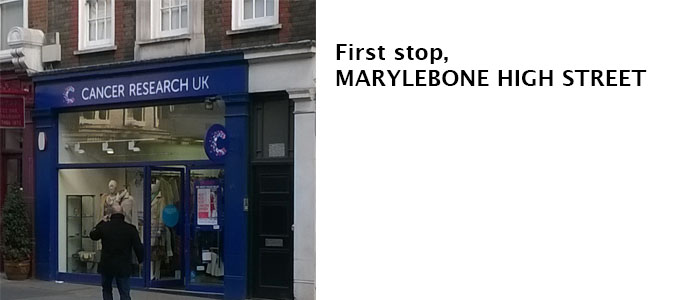
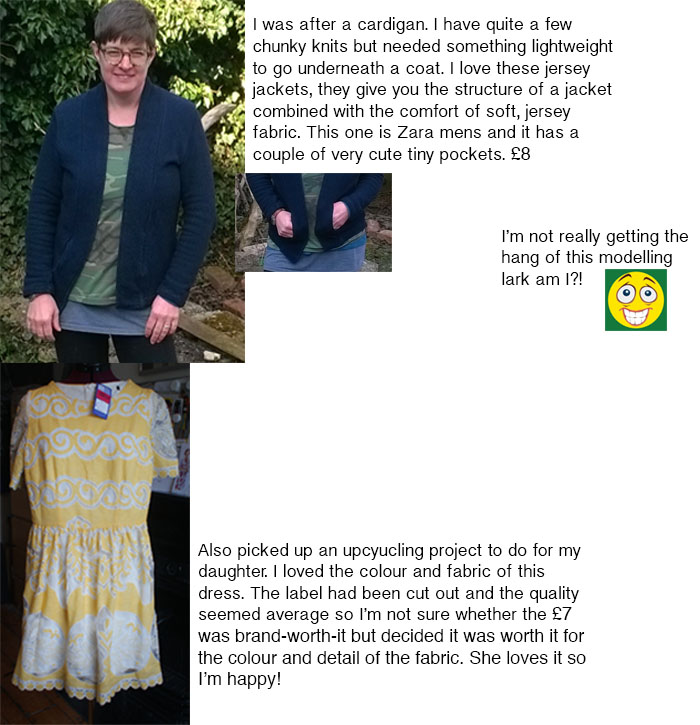
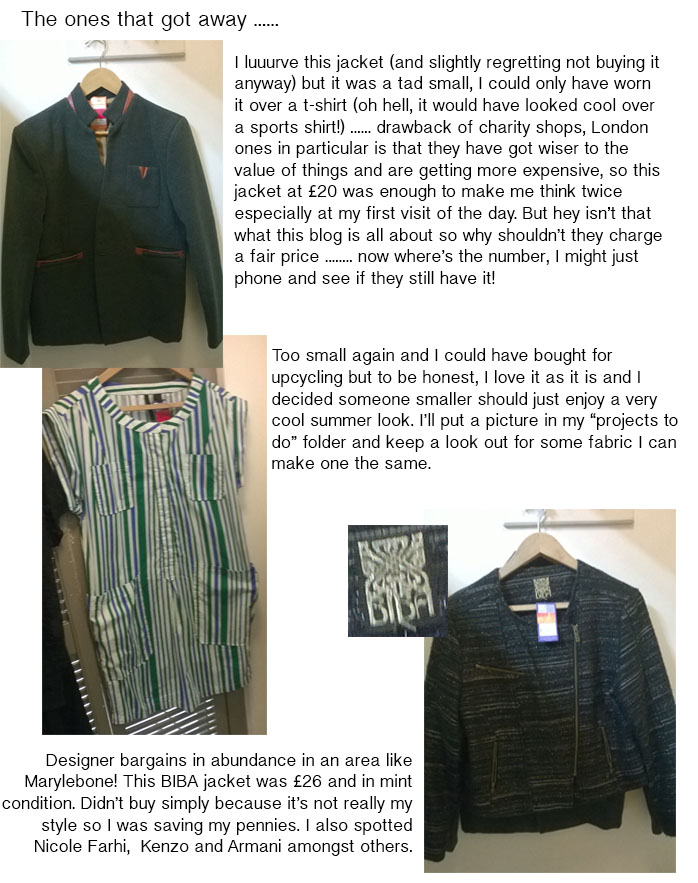
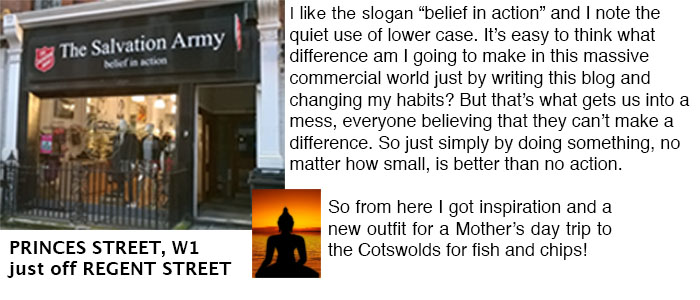
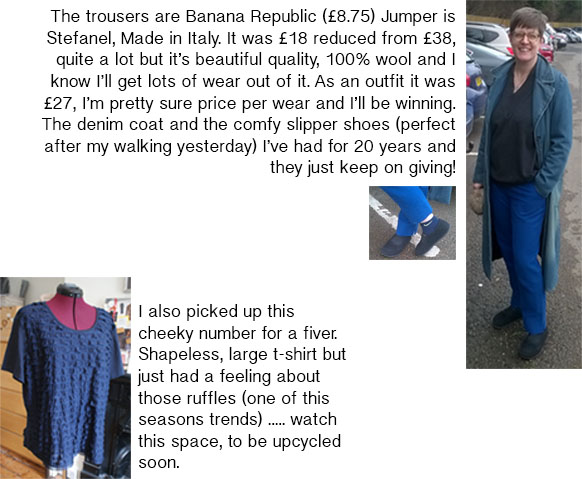
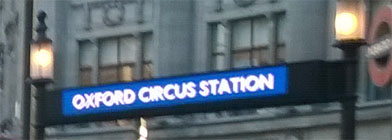
Next, I decided to throw myself to the other end of the commercial shopping spectrum. I’m after a new pair of trainers. Shoes are one item of my wardrobe I’m not so keen on buying second hand so I tend to take the approach that I buy new but I don’t buy very many, I keep them forever providing they fit and are street-worthy. The trainers I have are my old running shoes that I now wear for fashion, they are a bit wrecked and are not waterproof. I’d like a pair of Nike but where is the brand on ethics? So, I thought this would be a good place to start my brand research. I’ve been feeling a bit overwhelmed by this part of my research and couldn’t figure out how to tackle it, it’s a big industry and I currently use a number of brands, where do I start? On the train, I had read a report downloaded from the Free2Work website (Apparel Industry Trends 2015, The Truth Behind the Barcode). The report looks at companies policies towards workers throughout their supply chain and grades them on various aspects of employment. It’s produced by Baptist World Aid Australia so looks at the Australian market but it does feature Nike and contains good information on what aspects to look for and what brands should be doing. I considered it a positive that Nike were willing to be part of the research and they gained an overall grade B. I didn’t buy the trainers, I have more research to do but I had a wander through the store and picked out my favourite styles. It wouldn’t be like me to buy on the first visit anyway, I’m not an impulsive shopper but I do like to touch and feel the product before I buy so it was a worthwhile visit if I end up ordering online. I’ll share further research soon and hopefully make a decision before my existing pair fall to bits!
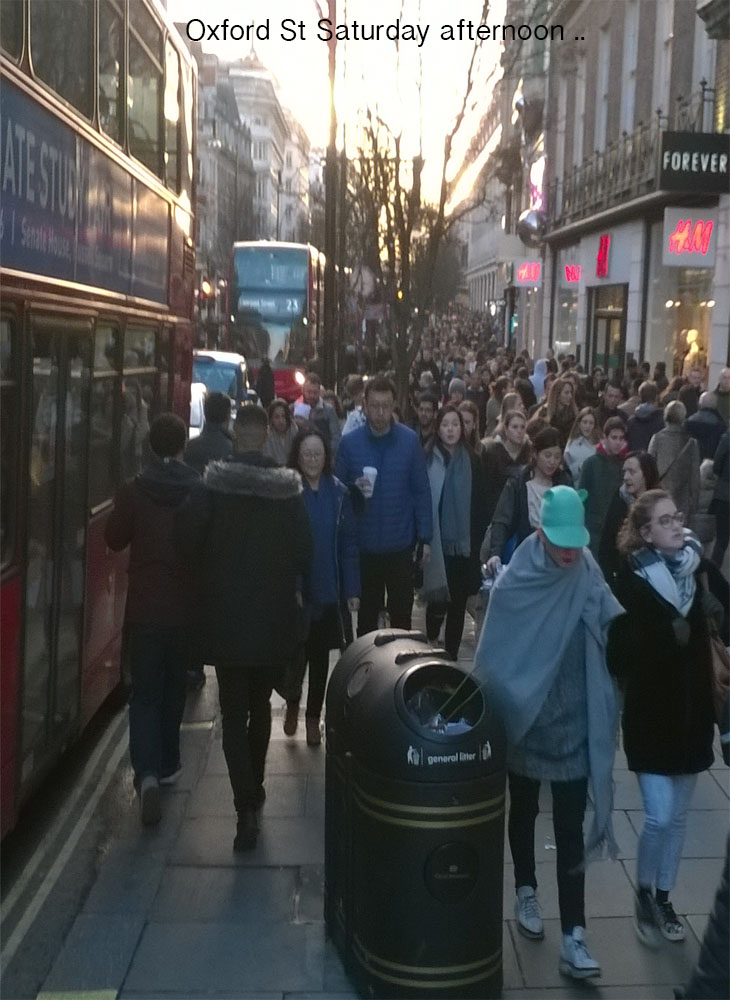
I stood watching these crowds for ages. I’ve seen them before lots of times, I lived here for 10years and one of the things I love about London is the chaos and craziness. But as I look more deeply into ethical fashion, I’m seeing them through different eyes. It’s Oxford Street, it’s shopping, heads down searching out the bargains, loaded with bags, spend, spend, spend. It’s mostly new clothes, the charity shops were not so busy! All I could think was “I’m looking at the next pile of landfill” when everyone gets their new purchases home and discards the old ones. Austerity doesn’t seem to be driving people to buy less, it’s just driving them to pay less. And manufacturers will keep producing, squeezing the supply chain as we keep our heads down, oblivious of what is really happening.
I made it through the crowds to M&S at Marble Arch to check out the new spring range Made With Integrity by Livia Firth. At first I couldn’t find it, then I asked a shop assistant and she couldn’t find it …. eventually we found it rather pushed into a corner, behind a large pillar. On Saturday, I was rather disappointed that the range wasn’t given a higher profile in store but after some research and further reflection, at least M&S are making a commitment to ethical fashion. I thought, I’ll hold fire on my criticism until I’ve researched further, the subject of a future post. The range? Great quality, good colours for smart workwear … beautiful leather bags but sadly out of my price range at £150 …. buy quality and have a bag for life though? Where does that feature on price per wear? I do have a bag I bought about 15years ago for £100 and I’ve probably used it 1000 times, price per wear 10p!
I co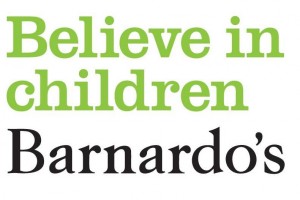 uldn’t find this one, as I trudged up and down George Street in Marylebone. By this time, it was pouring with rain, my paper bag got wet and broke, spilling my clothes over the pavement and I was still trying to find the shop at 5.55pm … such is the dedication of a second hand shopper. You need a kind of tenacious spirit for second hand because it can be hit and miss, some days you find nothing and some days you find real treasure .. but that’s what makes it so special. The belief that the next shop is at the foot of the rainbow and has gold just for you.
uldn’t find this one, as I trudged up and down George Street in Marylebone. By this time, it was pouring with rain, my paper bag got wet and broke, spilling my clothes over the pavement and I was still trying to find the shop at 5.55pm … such is the dedication of a second hand shopper. You need a kind of tenacious spirit for second hand because it can be hit and miss, some days you find nothing and some days you find real treasure .. but that’s what makes it so special. The belief that the next shop is at the foot of the rainbow and has gold just for you.
So my day was at and end and so was my energy, and those boots? Were NOT made for walking but I love these city streets and it was magic to be back. London Charity shops to a second hand junky are like Bond Street to brand seekers. I’d let a few items go that I might regret but I’ve wetted my appetite for more trips to London. Didn’t make it to Vogue 100 this time, but will plan a trip for April. I hobbled back to Paddington to find I had missed my train!
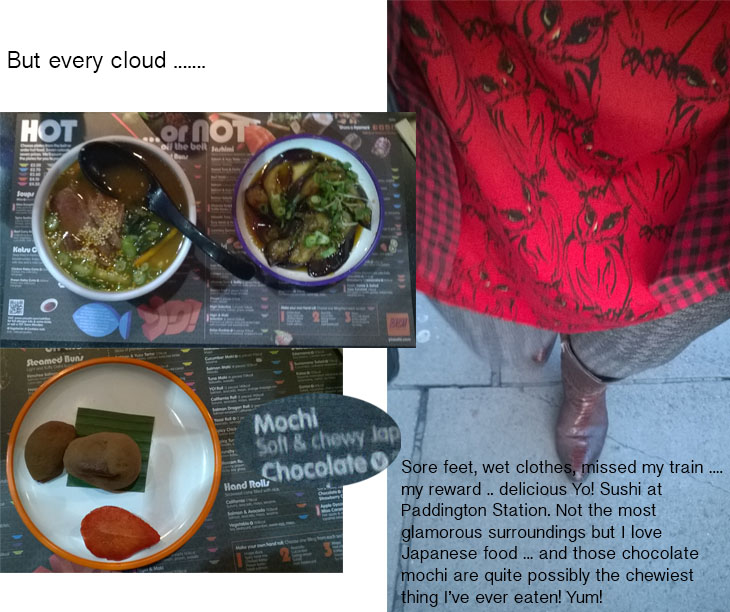
New Years Resolution number 4, Culture … thank you for coming to my party, I’m afraid I’m going home with the party bag!
Fancy a go at upcycling but not sure your own wardrobe is ready to be the guinea pig? Fancy dress costume is a great place to have a go. What’s more, if you do it for kids, they get the added bonus of helping to make it. It might not be as polished or flashy as a shop bought costume but I find the kids are more taken with the idea of having made their costumes than whether it looks exactly right or perfectly sewn.
I’ve just read an article from The Guardian about home sewing making a come back, which also said that sewing is sadly not taught in schools any more, so you can also provide them with a good start to a fun and essential life skill by having a go at sewing together.
We went double whammy with this one, an old blanket was upcycled and then upcycled again …. UP-UPCYCLED or DOUBLE UPCYCLED? I’m off to dig out some more pics of costumes past ….

I’ve shared the article from The Guardian on Facebook if anyone is interested.
Too many clothes but nothing to wear, Susie needed to edit … and found she actually had lots of great clothes to wear already in her wardrobe!
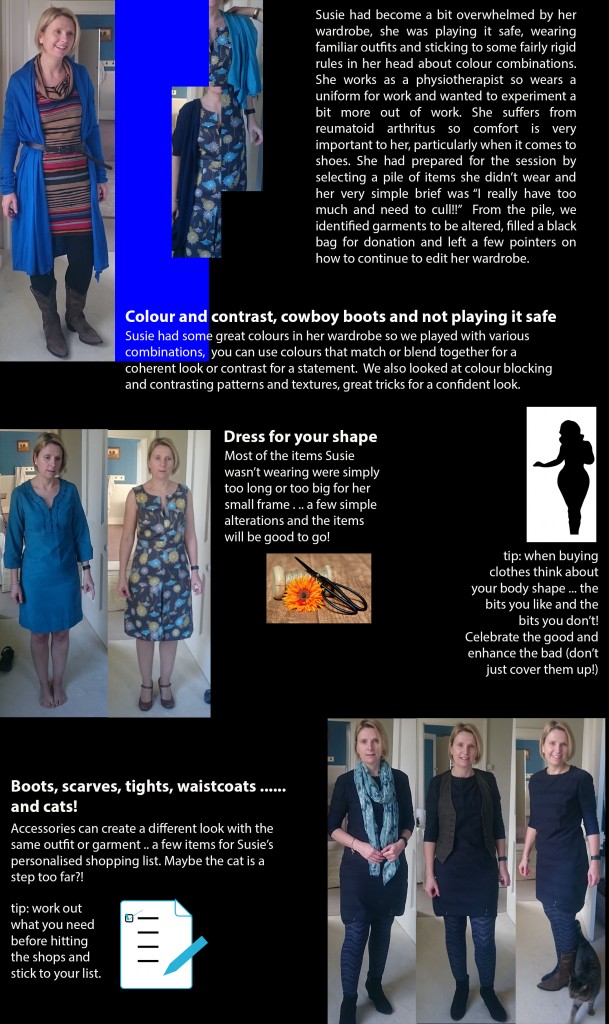
If it seems too good to be true … maybe it is?
Reducing what we buy is not just about decluttering, there are serious environmental and ethical reasons why we should address our shopping habits. On 24 April 2013 the Rana Plaza building in Bangladesh collapsed; 1,134 died and 2,500 were injured from 5 garment factories making clothes for the Western market.
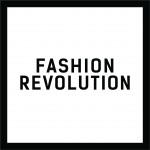 From this disaster professionals from the fashion industry formed the organisation Fashion Revolution, calling for big change and for us all to care more.
From this disaster professionals from the fashion industry formed the organisation Fashion Revolution, calling for big change and for us all to care more.
Here’s just a few shocking facts from their website www.fashionrevolution.org …… I’m asking myself,
IS THIS THE REAL COST OF OUR CLOTHES?
We all hear of injustices reported in the media but is this the downside of globalisation, have we become so used to political scaremongering that we don’t properly absorb this information? If we could see it happening on our doorsteps would we feel more moved to act against it perhaps?
 Last November, Hugh Fearnley-Whittingstall in his War on Waste TV programme stood at the top of a huge pile of 7 tons of clothes, 10 thousand garments and asked people how long they thought it took Britain to throw away that amount of clothes … some answers were way off and nobody was close to the real truth which is 10 minutes!
Last November, Hugh Fearnley-Whittingstall in his War on Waste TV programme stood at the top of a huge pile of 7 tons of clothes, 10 thousand garments and asked people how long they thought it took Britain to throw away that amount of clothes … some answers were way off and nobody was close to the real truth which is 10 minutes!
I’ve had a feeling rumbling in my head for years now that something is just not right when bargains look too good to be true. Fashion Revolution and Hugh’s pile of clothes really moved me to try and find out the real truth, do something about how I shop and question where I see my place in the fashion industry. I don’t want to make sweeping statements or hasty judgements about fashion brands but I want to find an affordable way to clothe and feed my family with a clear conscience. And I want to work somewhere where people are more important than profits.
Fashion Revolution calls for brands to be more transparent in their campaign asking,
It’s a simple question and one which previous generations would probably have been able to answer quite easily. We wear clothes every day and yet do we think about where they were made and by who? How transparent are brands in showing us this information, I don’t yet know? Either way, I’m going to find out. I’ve joined the Fashion Revolution, you can too …. check out their website for lots of tips from how to understand clothes labels to getting involved and finding out more.